Analysis and Experimental Investigation of the Light Dimming Effect on Automotive Visible Light Communications Performances
Abstract
:1. Introduction
2. State-of-the-Art in Light Dimming and Lights-Off Visible Light Communications
2.1. Light Dimming in IEEE 802.15.7 Standard for Optical Communications
2.2. Related Work
2.2.1. Single Carrier Modulations
2.2.2. Color Shift Keying Modulation
2.2.3. Multi-Carrier Modulation
2.2.4. Coding Techniques
3. Factors That Could Affect the Performances of Dimming in Visible Light Communications
4. Description of the Visible Light Communications System
4.1. Discussion of the VLC Emitter Structure
4.2. Discussion of the VLC Receiver Structure
5. Experimental Results
5.1. Experimental Procedure and Methods
5.2. Experimental Determinations Concerning the Effect of Pulse-Width Variation on the Light Intensity Output
5.3. Experimental Determinations Concerning the Effect of Pulse-Width Variation on Communication Performances
5.3.1. Indoor Testing Scenario and Results
5.3.2. Outdoor Testing Scenario and Results
6. Debate on the Results and on the Novelty of this Work
7. Conclusions
Author Contributions
Funding
Institutional Review Board Statement
Informed Consent Statement
Conflicts of Interest
References
- Masini, B.M.; Bazzi, A.; Zanella, A. A Survey on the Roadmap to Mandate on Board Connectivity and Enable V2V-Based Vehicular Sensor Networks. Sensors 2018, 18, 2207. [Google Scholar] [CrossRef] [Green Version]
- Zadobrischi, E.; Cosovanu, L.-M.; Dimian, M. Traffic Flow Density Model and Dynamic Traffic Congestion Model Simulation Based on Practice Case with Vehicle Network and System Traffic Intelligent Communication. Symmetry 2020, 12, 1172. [Google Scholar] [CrossRef]
- Zadobrischi, E.; Dimian, M. Inter-Urban Analysis of Pedestrian and Drivers through a Vehicular Network Based on Hybrid Communications Embedded in a Portable Car System and Advanced Image Processing Technologies. Remote Sens. 2021, 13, 1234. [Google Scholar] [CrossRef]
- Memedi, A.; Dressler, F. Vehicular Visible Light Communications: A Survey. IEEE Commun. Surv. Tutor. 2021, 23, 161–181. [Google Scholar] [CrossRef]
- Căilean, A.M.; Dimian, M. Current Challenges for Visible Light Communications Usage in Vehicle Applications: A Survey. IEEE Commun. Surv. Tutor. 2017, 19, 2681–2703. [Google Scholar] [CrossRef]
- Cole, M.; Clayton, H.; Martin, K. Solid-State Lighting: The New Normal in Lighting. IEEE Trans. Ind. Appl. 2015, 51, 109–119. [Google Scholar] [CrossRef]
- Long, X.; He, J.; Zhou, J.; Fang, L.; Zhou, X.; Ren, F.; Xu, T. A review on light-emitting diode based automotive headlamps. Renew. Sustain. Energy Rev. 2015, 41, 29–41. [Google Scholar] [CrossRef]
- Avătămăniței, S.A.; Căilean, A.M.; Zadobrischi, E.; Done, A.; Dimian, M.; Popa, V. Intensive Testing of Infrastructure-to-Vehicle Visible Light Communications in Real Outdoor Scenario: Evaluation of a 50 m link in Direct Sun Exposure. In Proceedings of the 2019 Global LIFI Congress (GLC), Paris, France, 12–13 June 2019; pp. 1–5. [Google Scholar] [CrossRef]
- Avătămăniței, S.A.; Căilean, A.-M.; Done, A.; Dimian, M.; Prelipceanu, M. Noise Resilient Outdoor Traffic Light Visible Light Communications System Based on Logarithmic Transimpedance Circuit: Experimental Demonstration of a 50 m Reliable Link in Direct Sun Exposure. Sensors 2020, 20, 909. [Google Scholar] [CrossRef] [Green Version]
- Avătămăniței, S.-A.; Căilean, A.-M.; Done, A.; Dimian, M.; Popa, V.; Prelipceanu, M. Design and Intensive Experimental Evaluation of an Enhanced Visible Light Communication System for Automotive Applications. Sensors 2020, 20, 3190. [Google Scholar] [CrossRef]
- Nawaz, T.; Seminara, M.; Caputo, S.; Mucchi, L.; Cataliotti, F.S.; Catani, J. IEEE 802.15.7-Compliant Ultra-Low Latency Relaying VLC System for Safety-Critical ITS. IEEE Trans. Veh. Technol. 2019, 68, 12040–12051. [Google Scholar] [CrossRef] [Green Version]
- Béchadergue, B.; Chassagne, L.; Guan, H. Vehicle-to-Vehicle Visible Light Phase-Shift Rangefinder Based on the Automotive Lighting. IEEE Sens. J. 2018, 18, 5334–5342. [Google Scholar] [CrossRef] [Green Version]
- Béchadergue, B.; Chassagne, L.; Guan, H. Simultaneous Visible Light Communication and Distance Measurement Based on the Automotive Lighting. IEEE Trans. Intell. Veh. 2019, 4, 532–547. [Google Scholar] [CrossRef]
- Beguni, C.; Avătămăniței, S.-A.; Căilean, A.-M.; Zadobrischi, E.; Dimian, M.; Guan, H.; Chassagne, L. Toward a mixed visible light communications and ranging system for automotive applications. In Proceedings of the 6th International Symposium on Electrical and Electronics Engineering (ISEEE), Galati, Romania, 18–20 October 2019; pp. 1–6. [Google Scholar] [CrossRef]
- Cailean, A.; Cagneau, B.; Chassagne., L.; Popa, V.; Dimian, M. A survey on the usage of DSRC and VLC in communication-based vehicle safety applications. In Proceedings of the IEEE 21st Symposium on Communications and Vehicular Technology in the Benelux (SCVT), Delft, The Netherlands, 10 November 2014; pp. 69–74. [Google Scholar] [CrossRef]
- IEEE Standard for Local and Metropolitan Area Networks-Part 15.7: Short-Range Optical Wireless Communications; IEEE Std 802.15.7-2018 (Revision of IEEE Std 802.15.7-2011); IEEE: Piscataway, NJ, USA, 2019; pp. 1–407. [CrossRef]
- Căilean, A.M.; Dimian, M. Impact of IEEE 802.15.7 Standard on Visible Light Communications Usage in Automotive Applications. IEEE Commun. Mag. 2017, 55, 169–175. [Google Scholar] [CrossRef]
- Rajagopal, S.; Roberts, R.D.; Lim, S.-K. IEEE 802.15.7 visible light communication: Modulation schemes and dimming support. IEEE Commun. Mag. 2012, 50, 72–82. [Google Scholar] [CrossRef]
- Boucouvalas, A.C.; Chatzimisios, P.; Ghassemlooy, Z.; Uysal, M.; Yiannopoulos, K. Standards for indoor Optical Wireless Communications. IEEE Commun. Mag. 2015, 53, 24–31. [Google Scholar] [CrossRef]
- Uysal, M. Visible Light Communications: From Theory to Industrial Standardization. In Proceedings of the 2019 Optical Fiber Communications Conference and Exhibition (OFC), San Diego, CA, USA, 3–7 March 2019; pp. 1–3. [Google Scholar] [CrossRef]
- Georlette, V.; Moeyaert, V.; Bette, S.; Point, N. Outdoor Optical Wireless Communication: Potentials, standardization and challenges for Smart Cities. In Proceedings of the 29th Wireless and Optical Communications Conference (WOCC), Newark, NJ, USA, 1–2 May 2020; pp. 1–6. [Google Scholar] [CrossRef]
- Zafar, F.; Karunatilaka, D.; Parthiban, R. Dimming schemes for visible light communication: The state of research. IEEE Wirel. Commun. 2015, 22, 29–35. [Google Scholar] [CrossRef]
- Dyble, M.; Narendran, N.; Bierman, A.; Klein, T. Impact of Dimming White LEDs: Chromaticity Shifts Due to Different Dimming Methods. In Proceedings of the SPIE-The International Society for Optical Engineering, San Diego, CA, USA, 31 July–4 August 2005; pp. 291–299. [Google Scholar] [CrossRef]
- Idris, S.; Aibinu, A.M.; Koyunlu, G.; Sanusi, J. A Survey of Modulation Schemes in Visible Light Communications. In Proceedings of the 2019 3rd International Conference on Trends in Electronics and Informatics (ICOEI), Tirunelveli, India, 23-25 April 2019; pp. 1–7. [Google Scholar] [CrossRef]
- Borogovac, T.; Rahaim, M.B.; Tuganbayeva, M.; Little, T.D.C. “Lights-off” visible light communications. In Proceedings of the 2011 IEEE GLOBECOM Workshops (GC Wkshps), Houston, TX, USA, 5–9 December 2011; pp. 797–801. [Google Scholar] [CrossRef]
- Yoo, J.; Kim, B.W.; Jung, S. Modelling and analysis of M-ary variable pulse position modulation for visible light communications. IET Optoelectron. 2015, 9, 184–190. [Google Scholar] [CrossRef]
- Lee, S.H.; Ahn, B.G.; Ju, M.C.; Park, Y. A Modified VPPM Algorithm of VLC Systems Suitable for Fast Dimming Environment. Opt. Commun. 2016, 365, 43–48. [Google Scholar] [CrossRef]
- Lee, K.; Park, H. Modulations for visible light communications with dimming control. IEEE Photonics Technol. Lett. 2011, 23, 1136–1138. [Google Scholar] [CrossRef]
- Sugiyama, H.; Nosu, K. MPPM: A Method for Improving the Band–Utilization Efficiency in Optical PPM. J. Lightw. Technol. 1989, 7, 465–472. [Google Scholar] [CrossRef]
- Siddique, A.B.; Tahir, M. Joint brightness control and data transmission for visible light communication systems based on white LEDs. In Proceedings of the 2011 IEEE Consumer Communications and Networking Conference (CCNC), Las Vegas, NV, USA, 9–12 January 2011; pp. 1026–1030. [Google Scholar] [CrossRef]
- Deng, K.; Wan, Y.; Lu, Y. MPPM based dimming control scheme in visible light communication systems. Opt. Commun. 2019, 451, 168–173. [Google Scholar] [CrossRef]
- Tian, Z.; Wright, K.; Zhou, X. The darklight rises: Visible light communication in the dark. In Proceedings of the 22nd Annual International Conference on Mobile Computing and Networking, New York, NY, USA, 3–7 October 2016; pp. 495–496. [Google Scholar] [CrossRef]
- El Gamal, M.M.; Fayed, H.A.; Aly, M.H.; Ismail, N.E.; Mokhtar, A. Interactive internet of things based on dark light system for smart room. Opt. Quantum Electron. 2020, 52, 493. [Google Scholar] [CrossRef]
- Wang, J.Y.; Wang, J.B.; Chen, M.; Song, X. Dimming scheme analysis for pulse amplitude modulated visible light communications. In Proceedings of the 2013 International Conference on Wireless Communications and Signal Processing, Hangzhou, China, 24–26 October 2013; pp. 1–6. [Google Scholar] [CrossRef]
- Lee, S.H.; Ahn, K.I.; Kwon, J.K. Multilevel transmission in dimmable visible light communication systems. J. Lightw. Technol. 2013, 31, 3267–3276. [Google Scholar] [CrossRef]
- Bai, B.; He, Q.; Xu, Z.; Fan, Y. The color shift key modulation with non-uniform signaling for visible light communication. In Proceedings of the 1st IEEE International Conference on Communications in China Workshops (ICCC), Beijing, China, 15–18 August 2012; pp. 37–42. [Google Scholar] [CrossRef]
- Ahn, K.-I.; Kwon, J.K. Color intensity modulation for multicolored visible light communications. IEEE Photon. Technol. Lett. 2012, 24, 2254–2257. [Google Scholar] [CrossRef]
- Delgado Rajó, F.A.; Guerra, V.; Rabadán Borges, J.A.; Torres, J.R.; Pérez-Jiménez, R. Color shift keying communication system with a modified PPM synchronization scheme. IEEE Photonics Technol. Lett. 2014, 26, 1851–1854. [Google Scholar] [CrossRef]
- Shieh, W.; Djordjevic, I. OFDM for Optical Communications; Academic Press/Elsevier: Burlington, MA, USA, 2010. [Google Scholar]
- Wang, Z.; Zhong, W.D.; Yu, C.; Chen, J.; Francois, C.P.S.; Chen, W. Performance of dimming control scheme in visible light communication system. Optics Express 2012, 20, 18861–18868. [Google Scholar] [CrossRef] [PubMed]
- Lee, S.H.; Jung, S.; Kwon, J.K. Modulation and Coding for Dimmable Visible Light Communication. Opt. Commun. 2015, 27, 136–143. [Google Scholar] [CrossRef]
- Yoo, J.-H.; Jung, S.-Y. Modeling and analysis of variable PPM for visible light communications. J. Wirel. Commun. Netw. 2013, 134. [Google Scholar] [CrossRef] [Green Version]
- Avătămăniței, S.-A.; Beguni, C.; Căilean, A.-M.; Dimian, M.; Popa, V. Evaluation of Misalignment Effect in Vehicle-to-Vehicle Visible Light Communications: Experimental Demonstration of a 75 Meters Link. Sensors 2021, 21, 3577. [Google Scholar] [CrossRef]
- Ucar, S.; Turan, B.; Ergen, S.C.; Ozkasap, O.; Ergen, M. Dimming support for visible light communication in intelligent transportation and traffic system. In Proceedings of the NOMS 2016—2016 IEEE/IFIP Network Operations and Management Symposium, Istanbul, Turkey, 25–29 April 2016; pp. 1193–1196. [Google Scholar] [CrossRef]
- Shen, W.; Tsai, H. Testing vehicle-to-vehicle visible light communications in real-world driving scenarios. In Proceedings of the 2017 IEEE Vehicular Networking Conference (VNC), Torino, Italy, 27–29 November 2017; pp. 187–194. [Google Scholar] [CrossRef]
- Kim, Y.H.; Cahyadi, W.A.; Chung, Y.H. Experimental Demonstration of VLC-Based Vehicle-to-Vehicle Communications under Fog Conditions. IEEE Photonics J. 2015, 7, 7905309. [Google Scholar] [CrossRef]
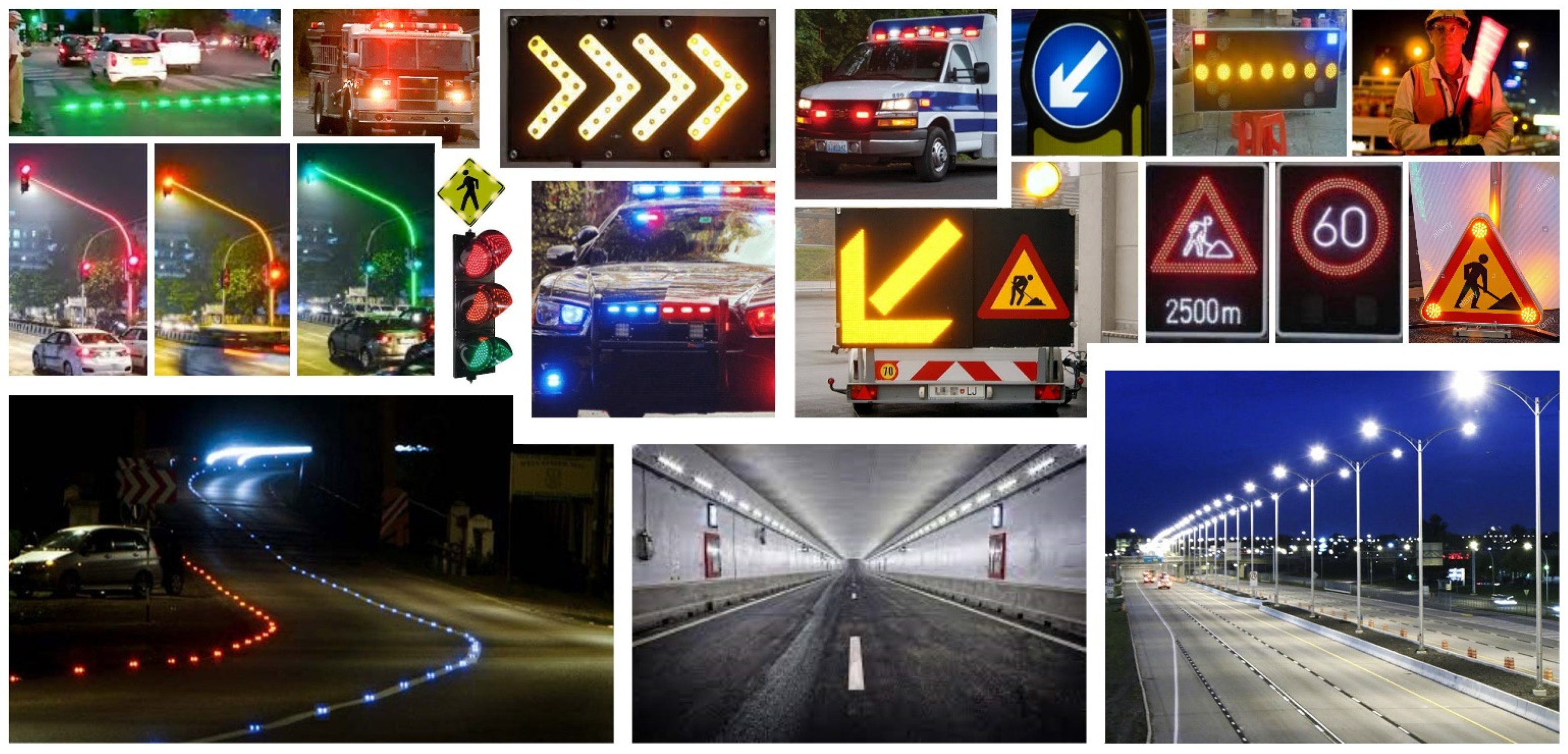
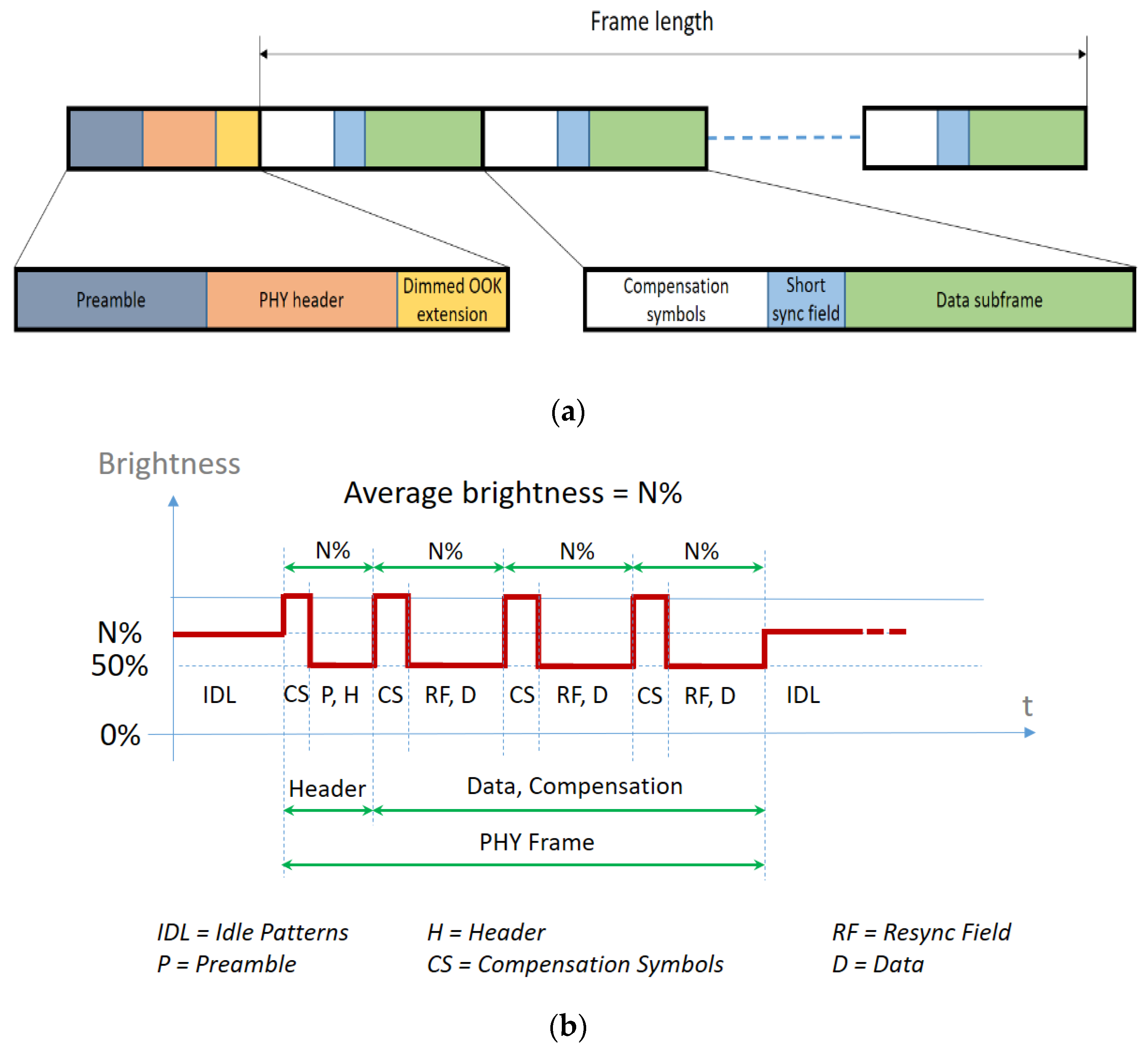
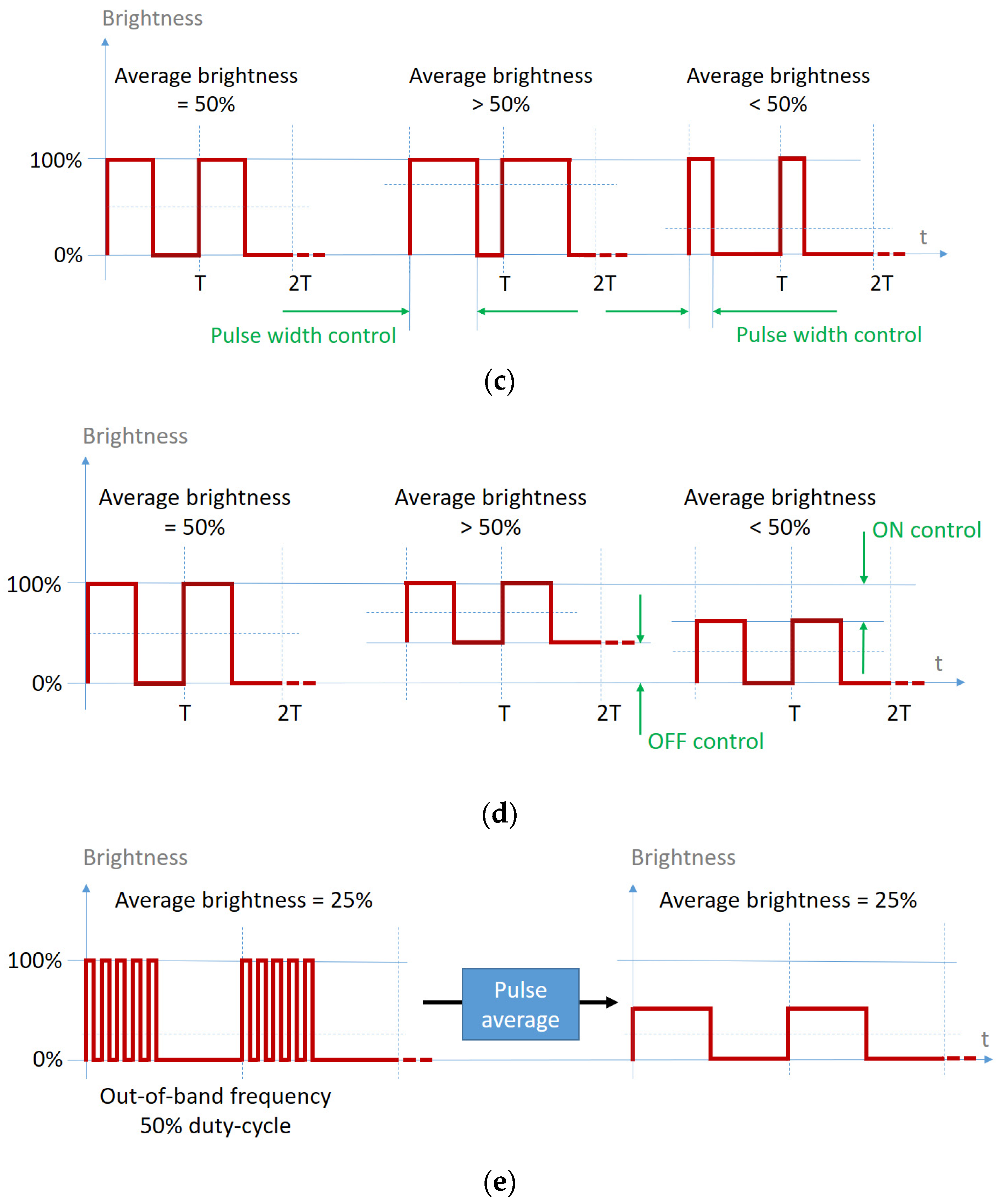
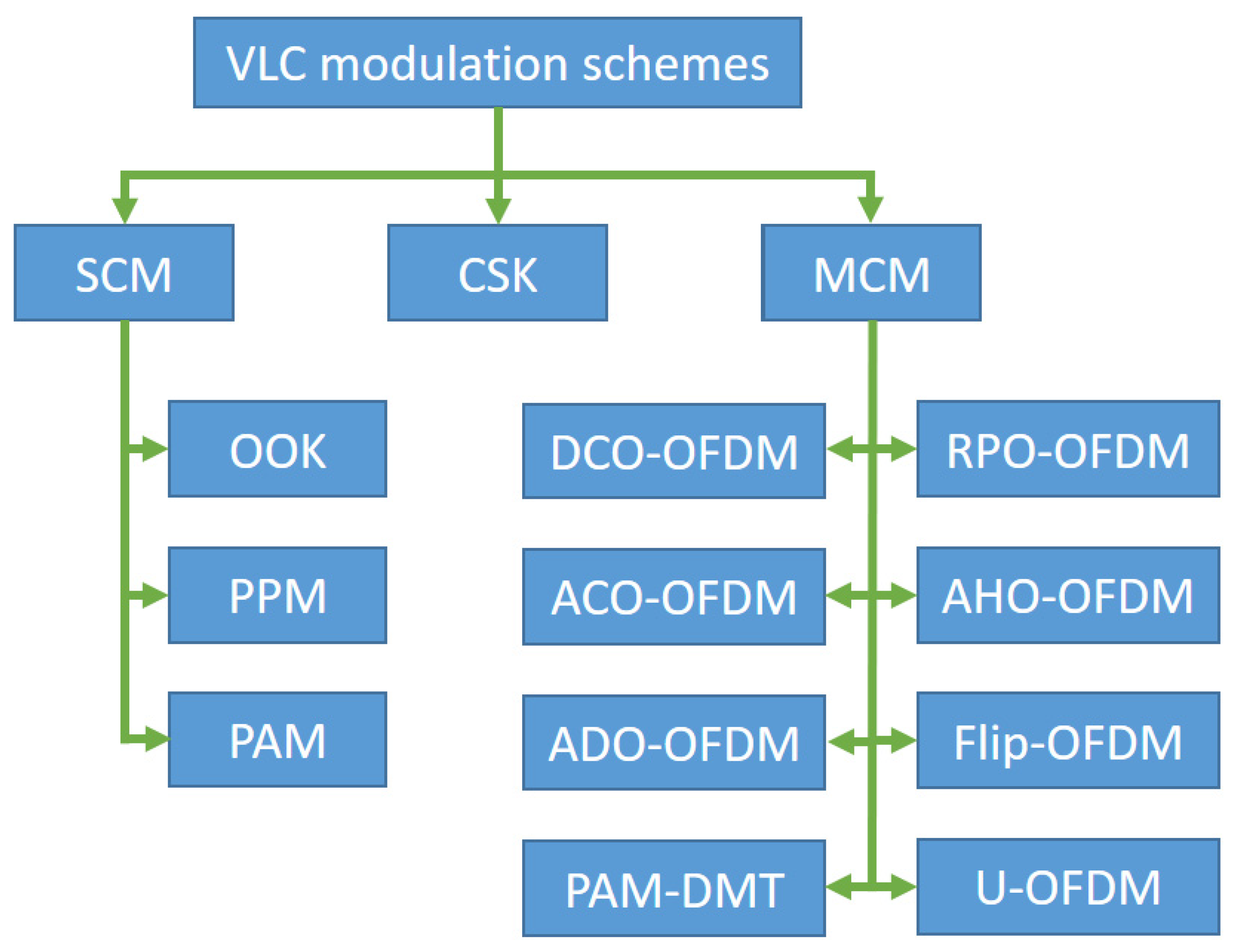



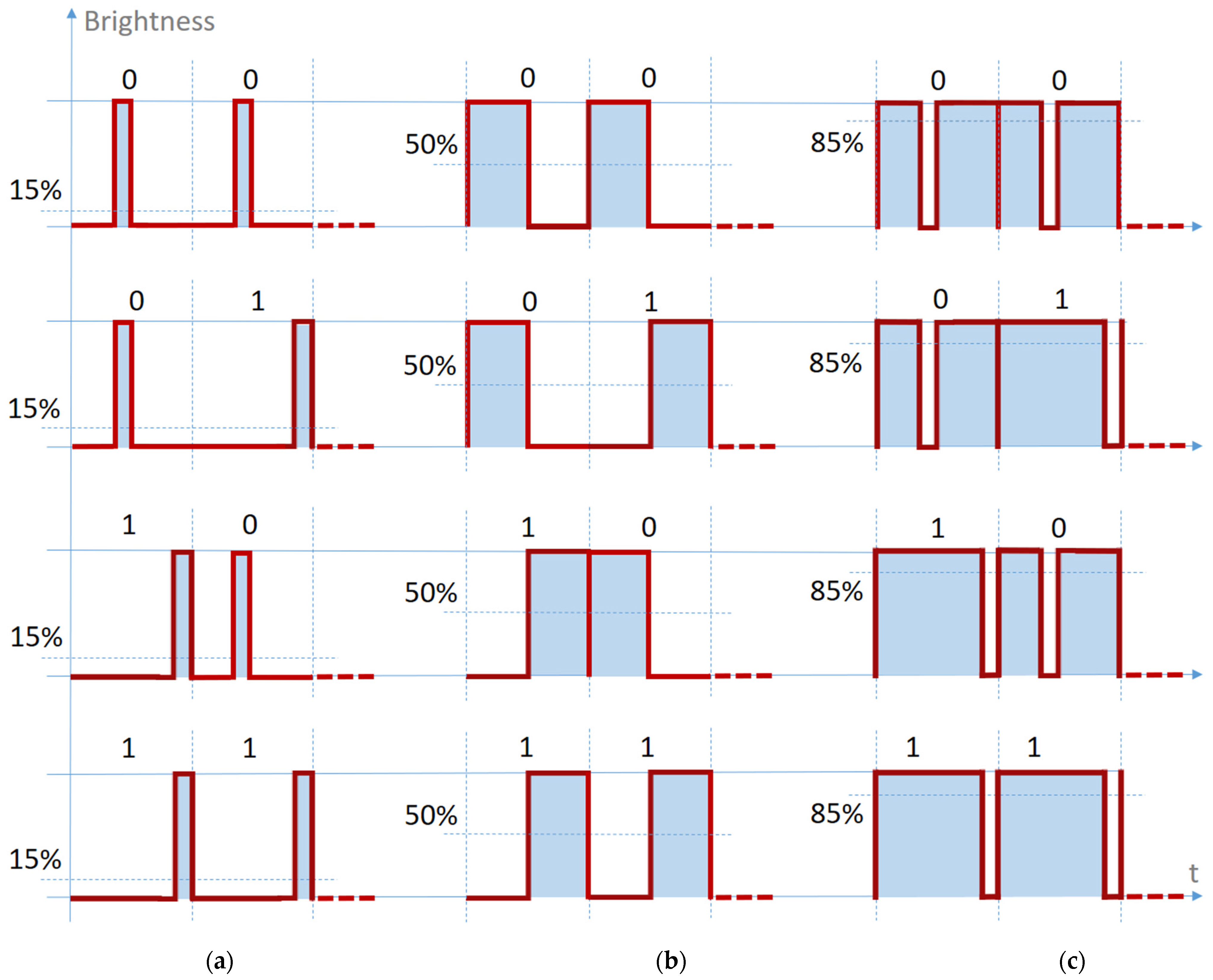


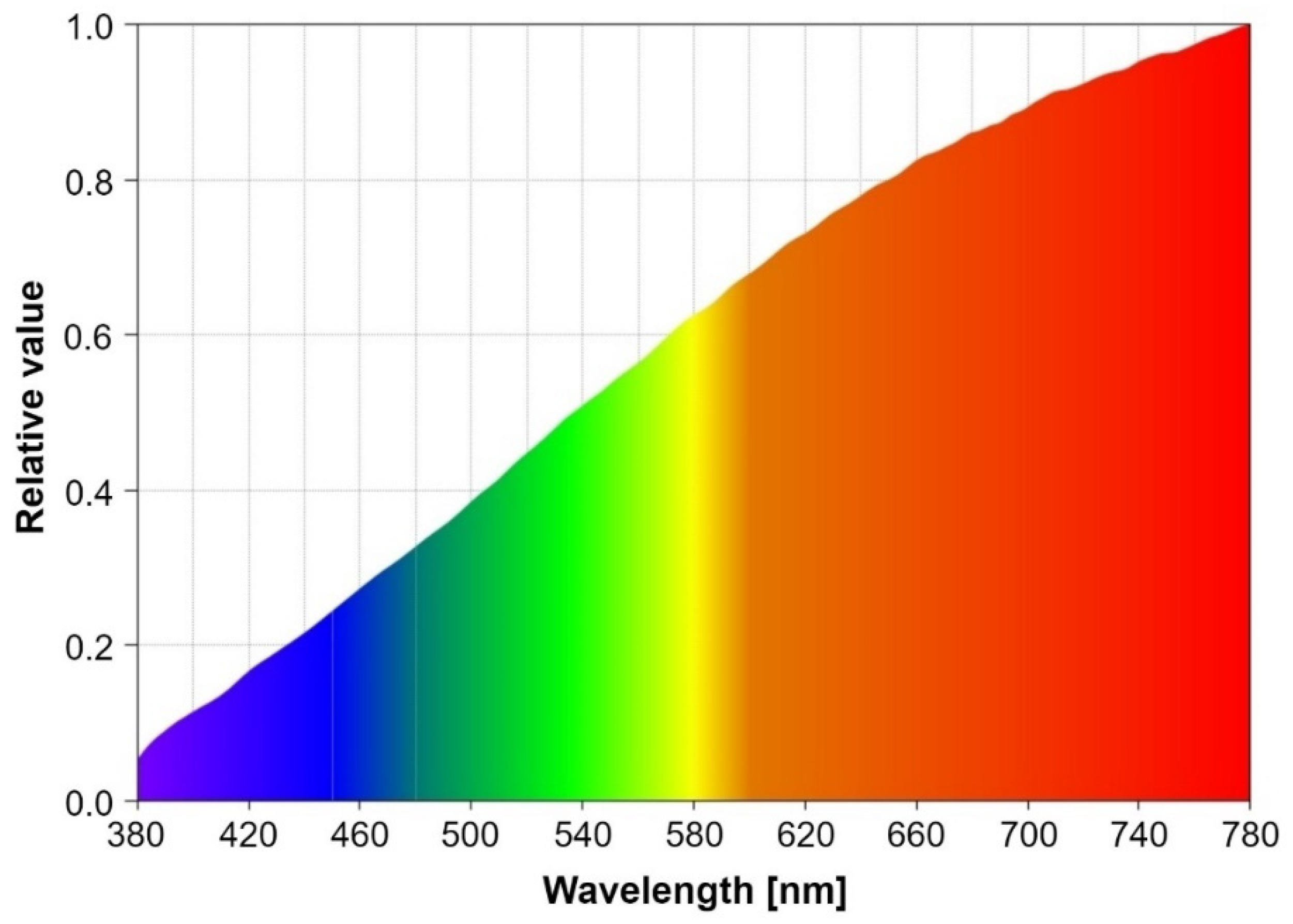
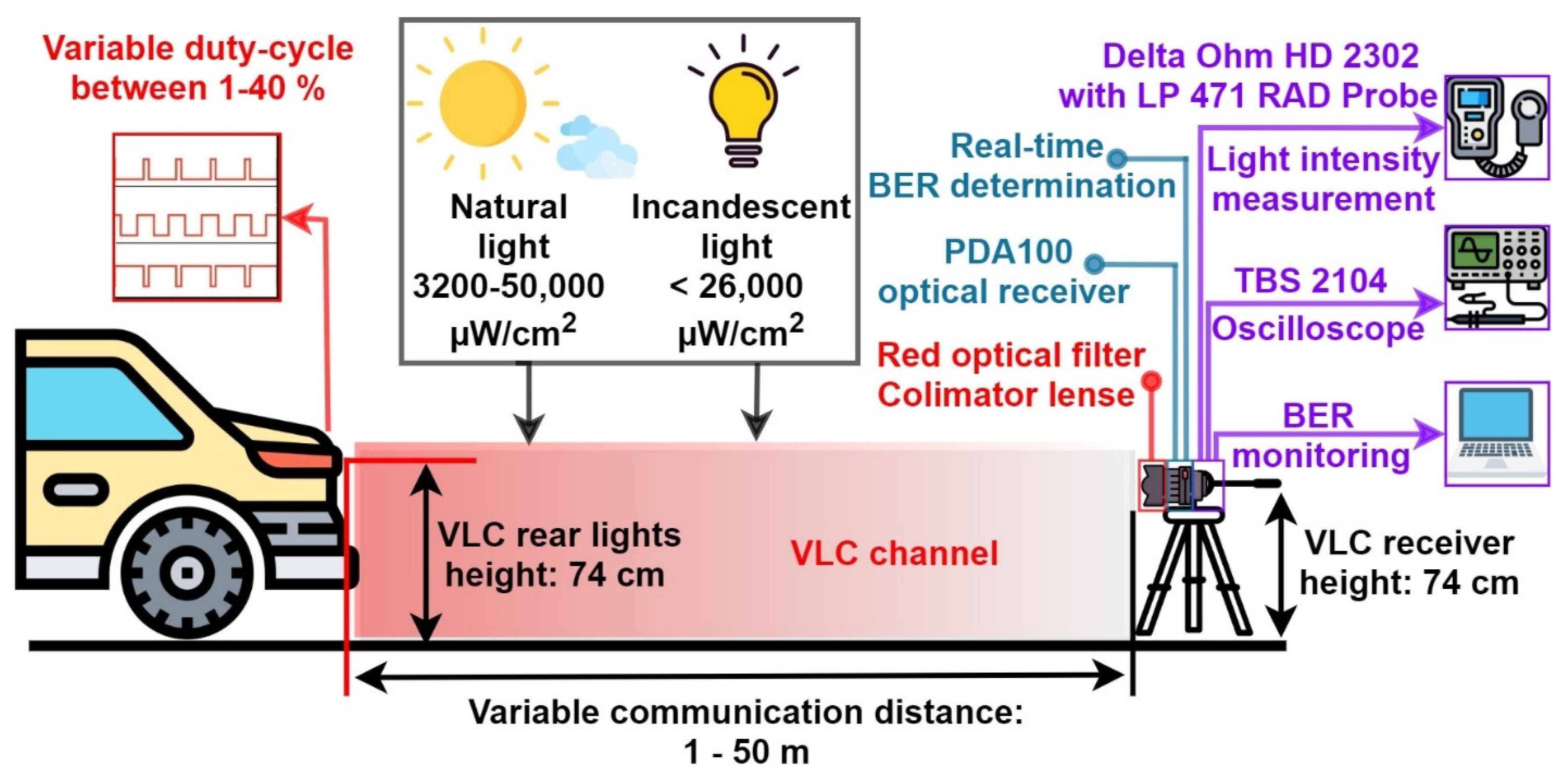
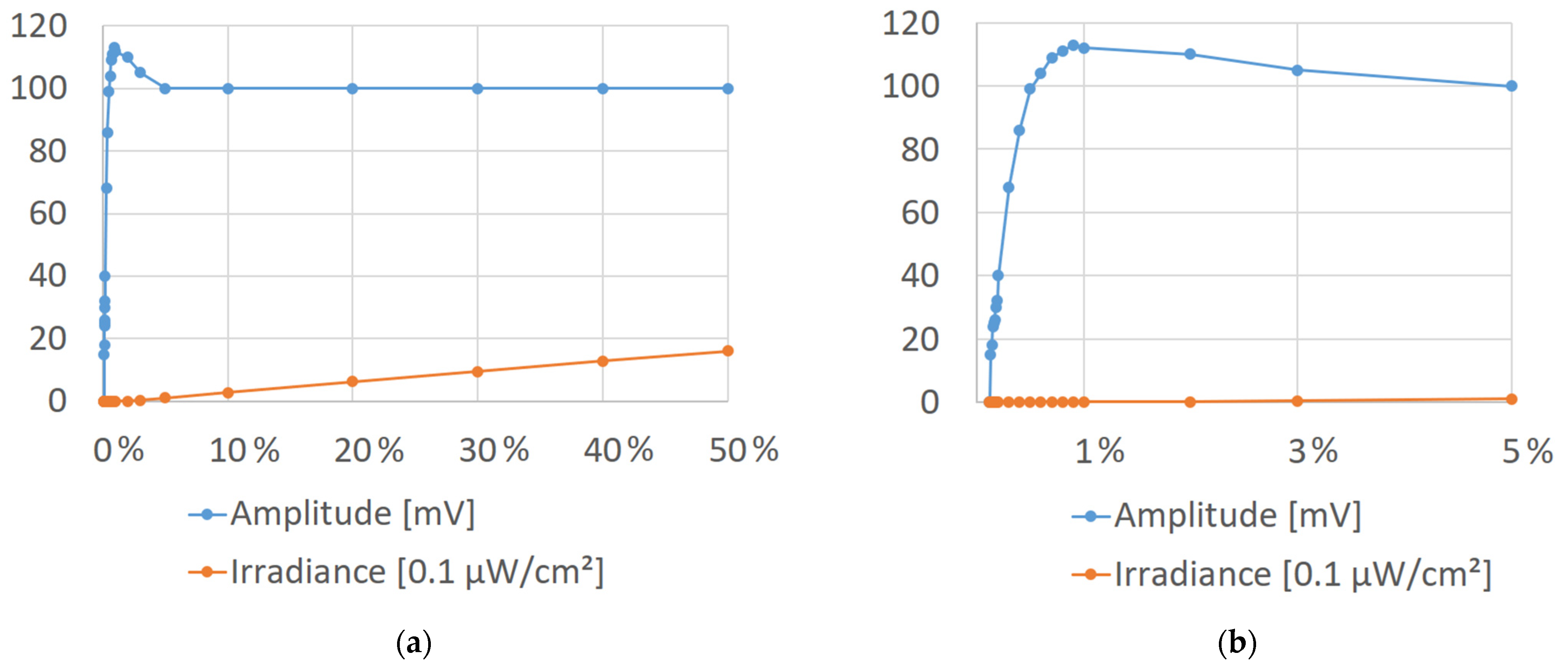

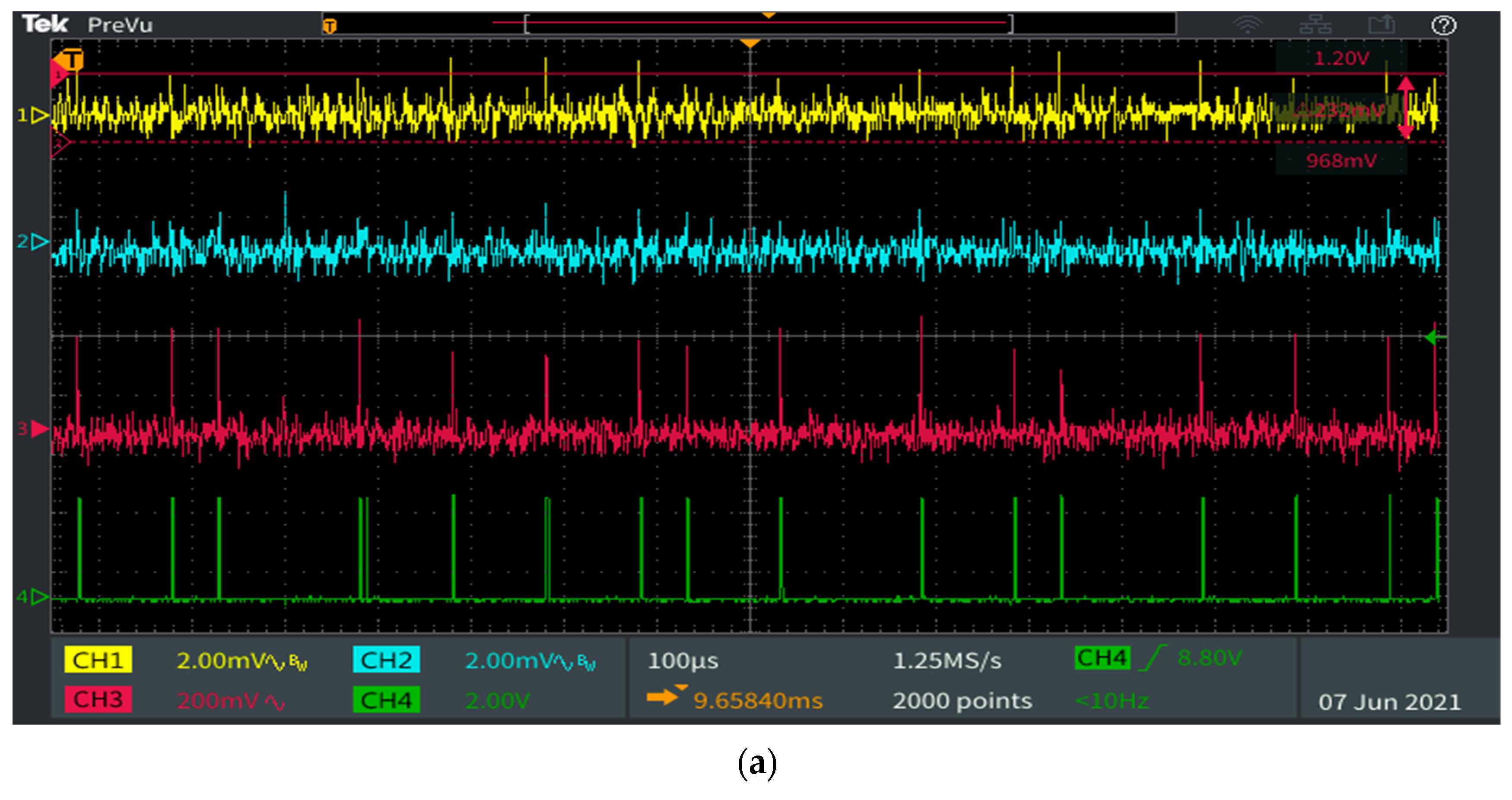



| Modulation | RLL Code | Optical Clock Rate (kHz) | FEC | Data Rate (kbps) | |
|---|---|---|---|---|---|
| Outer Code (RS) | Inner Code (CC) | ||||
| OOK | Manchester | 200 | (15, 7) | 1/4 | 11.67 |
| (15, 11) | 1/3 | 24.44 | |||
| (15, 11) | 2/3 | 48.89 | |||
| (15, 11) | none | 73.3 | |||
| none | none | 100 | |||
| VPPM | 4B6B | 400 | (15, 2) | none | 35.56 |
| (15, 4) | none | 71.11 | |||
| (15, 7) | none | 124.4 | |||
| none | none | 266.6 | |||
| Logical Value | Physical Value d is the VPPM Duty Cycle (0.1 ≤ d ≤ 0.9) | |
|---|---|---|
| 0 | High | 0 ≤ t < dT |
| Low | dT ≤ t < T | |
| 1 | Low | 0 ≤ t < (1−d)T |
| High | (1−d)T ≤ t < T | |
| Logical Value | Duty Cycle Value d is the Duty Cycle | Physical Value T Is the Bit Period | |
|---|---|---|---|
| 0 | 1% ≤ d < 50% | Low | 0 ≤ t < (0.5d)T |
| High | (0.5−d)T ≤ t < 0.5T | ||
| Low | 0.5T ≤ t < T | ||
| d = 50% Manchester | High | 0 ≤ t < dT | |
| Low | dT ≤ t < T | ||
| 50% < d < 99% | High | 0 ≤ t < (d−0.5)T | |
| Low | (d−0.5)T ≤ t < 0.5T | ||
| High | 0.5T ≤ t < T | ||
| 1 | 1% ≤ d < 50% | Low | 0 ≤ t < (1−d)T |
| High | (1−d)T ≤ t < T | ||
| d = 50% Manchester | Low | 0 ≤ t < (1−d)T | |
| High | (1−d)T ≤ t < T | ||
| 50% < d < 99% | High | 0 ≤ t < (1−d)T | |
| Low | (1−d)T ≤ t < T | ||
| Parameter | Feature/Values |
|---|---|
| Testing conditions | High SNR indoor conditions Indoor conditions In the presence of parasitic lights (low SNR) Outdoor, uncontrolled conditions |
| Dimming factor | 1–40% |
| VLC emitter | LED-based vehicle rear lights |
| Emitter-Receiver (V2V) distance | 1–50 m |
| VLC receiver | PIN Photodiode-based |
| VLC receiver height | 74 cm |
| Modulation technique | VPPM |
| Data rate | 10 kb/s |
| Measured parameter | Real-time BER determination without the use of forward error correcting protocols |
| Parameter | Feature/Value |
|---|---|
| Light source | Incandescent light source |
| Light source power | 6 × 70 W |
| Light color temperature | 3254 K |
| Light source irradiance | Up to 28,000 µW/cm2 |
| Equipment type | Equipment |
|---|---|
| Spectral analyzer | Sekonic C800 |
| Irradiance meter | Delta Ohm HD 2302.0 with LP 471 RAD Probe |
| Oscilloscope | Tektronix TBS 2104 |
| Pulse Width | Modulation | Data Rate (kB/s) | VLC Distance (m) | BER | Conditions |
|---|---|---|---|---|---|
| 1–40% | VPPM | 10 | 1–40 | <10−6 | High SNR conditions: no artificial light sources and limited daylight |
| 1–40% | VPPM | 10 | 1–40 | <10−6 | Low SNR conditions: the VLC receiver is directly exposed to an incandescent light source of 18,500 µW/cm2 |
| 2–40% | VPPM | 10 | 1–40 | <10−6 | Low SNR conditions: the VLC receiver is directly exposed to an incandescent light source of 26,000 µW/cm2 |
| 1% | VPPM | 10 | 1–35 | <10−6 | |
| 1% | VPPM | 10 | 35–40 | <1942 × 10−4 | Low SNR conditions: 26,000 µW/cm2 incandescent light |
Publisher’s Note: MDPI stays neutral with regard to jurisdictional claims in published maps and institutional affiliations. |
© 2021 by the authors. Licensee MDPI, Basel, Switzerland. This article is an open access article distributed under the terms and conditions of the Creative Commons Attribution (CC BY) license (https://creativecommons.org/licenses/by/4.0/).
Share and Cite
Beguni, C.; Căilean, A.-M.; Avătămăniței, S.-A.; Dimian, M. Analysis and Experimental Investigation of the Light Dimming Effect on Automotive Visible Light Communications Performances. Sensors 2021, 21, 4446. https://doi.org/10.3390/s21134446
Beguni C, Căilean A-M, Avătămăniței S-A, Dimian M. Analysis and Experimental Investigation of the Light Dimming Effect on Automotive Visible Light Communications Performances. Sensors. 2021; 21(13):4446. https://doi.org/10.3390/s21134446
Chicago/Turabian StyleBeguni, Cătălin, Alin-Mihai Căilean, Sebastian-Andrei Avătămăniței, and Mihai Dimian. 2021. "Analysis and Experimental Investigation of the Light Dimming Effect on Automotive Visible Light Communications Performances" Sensors 21, no. 13: 4446. https://doi.org/10.3390/s21134446
APA StyleBeguni, C., Căilean, A.-M., Avătămăniței, S.-A., & Dimian, M. (2021). Analysis and Experimental Investigation of the Light Dimming Effect on Automotive Visible Light Communications Performances. Sensors, 21(13), 4446. https://doi.org/10.3390/s21134446






